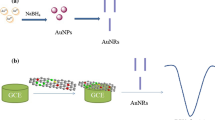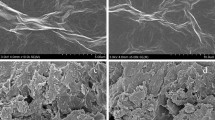Abstract
A mandatory step in any sensor fabrication is the introduction of analyte-specific recognition elements to the transducer surface. In this study, the possibility to anchor β-cyclodextrin-modified dopamine to a reduced graphene oxide based electrochemical transducer for the sensitive and selective sensing of folic acid is demonstrated. The sensor displays good electrocatalytic activity toward the oxidation of folic acid. The strong affinity of the surface-confined β-cyclodextrin for folic acid, together with favorable electron transfer characteristics, resulted in a sensor with a detection limit of 1 nM for folic acid and a linear response up to 10 μM. Testing of the sensor on serum samples from healthy individuals and patients diagnosed with folic acid deficiency validated the sensing capability.

Graphical abstract






Similar content being viewed by others
References
Ambrosi A, Chua CK, Latiff NM, Loo AH, Wong CHA, Eng AYS, et al. Graphene and its electrochemistry - an update. Chem Soc Rev. 2016;45:2458–93.
Szunerits S, Boukherroub R. Graphene-based bioelectrochemistry and bioelectronics: a concept for the future? Curr Opin Electrochem. 2018;12:141–7.
Szunerits S, Boukherroub R. Graphene-based nanomaterials in innovative electrochemistry. Curr Opin Electrochem. 2018;10:24–30.
Jijie R, Kahlouche K, Barras A, Bouckaert J, Tijani Gharbi T, Szunerits S, et al. Reduced graphene oxide/polyethylenimine based immunosensor for the selective and sensitive electrochemical detection of uropathogenic Escherichia coli. Sensors Actuators B Chem. 2018;260:255–63.
Kahlouche K;R, Jijie IH, Barras A, Gharbi T, Yahiaoui R, Herlem G, et al. Controlled modification of electrochemical microsystems with polyethylenimine/reduced graphene oxide using electrophoretic deposition: sensing of dopamine levels in meat samples. Talanta. 2018;178:432–40.
Kaminska I, Barras A, Coffinier Y, Lisowski W, Niedziolka-Jonsson J, Woisel P, et al. Preparation of a responsive carbohydrate-coated biointerface based on graphene/azido-terminated tetrathiafulvalene nanohybrid material. ACS Appl Mater Interfaces. 2012;4:5386.
Kaminska I, Das MR, Coffinier Y, Niedziolka-Jonsson J, Woisel P, Opallo M, et al. Preparation of graphene/tetrathiafulvalene nanocomposite switchable surfaces. Chem Commun. 2012;48:1221.
Xu LQ, Yang WJ, Neoh K-G, Kang E-T, Fu GD. Dopamine-induced reduction and functionalization of graphene oxide nanosheets. Macromolecules. 2010;48:8336.
Kaminska I, Das MR, Coffinier Y, Niedziolka-Jonsson J, Sobczak J, Woisel P, et al. Reduction and functionalization of graphene oxide sheets using biomimetic dopamine derivatives in one step. ACS Appl Mater Interfaces. 2012;4:1016.
Szejtli J. Introduction and general overview of cyclodextrin chemistry. Chem Rev. 1998;98:1743–54.
Yu G, Jie K, Huang F. Supramolecular amphiphiles based on host-guest molecular recognition motifs. Chem Rev. 2015;115:7240–303.
Fritea L, Le Goff A, Putaux J-L, Tertis M, Cristea C, Săndulescu R, et al. Design of a reduced-graphene-oxide composite electrode from an elctropolymerizable graphene aqueous dispersion using a cyclodextrin-pyrrole monomer. Application to dopamine biosensing. Electrochim Acta. 2015;178:108–12.
Harley CC, Rooney AD, Breslin CB. The selective detection of dopamine at a polypyrrole film doped with sulfonated β-cyclodextrins. Sensors Actuators B Chem. 2010;150:498–504.
Tian X. Simultaneous determination of l-ascorbic acid, dopamine and uric acid with gold nanoparticles-β-cyclodextrin-graphene-modified electrode by square wave voltammetry. Talanta. 2012;93:79–85.
Wen D, Liu W, Herrmann A-K, Haubold D, Holzschuh M, Simon F, et al. Simple and sensitive colorimetric detection of dopamine based on assembly of cyclodextrin-modified Au nanoparticles. Small. 2016;12:2439–42.
Wu Y, Dou Z, Liu Y, Lv G, Pua T, He X. Dopamine sensor development based on the modification of glassy carbon electrode with β-cyclodextrin-poly(N-isopropylacrylamide). RSC Adv. 2013;3:12726–34.
Subhadeep S, Aditi R, Kanak R, Mahendra NR. Study to explore the mechanism to form inclusion complexes of β-cyclodextrin with vitamin molecules. Sci Rep. 2016;6:35764.
Liang W, Rong Y, Fan L, Dong W, Dong Q, Yang C, et al. 3D graphene/hydroxypropyl-β-cyclodextrin nanocomposite as an electrochemical chiral sensor for the recognition of tryptophan enantiomers. J Mater Chem C. 2018;6:12822–9.
Tao Y, Dai J, Kong Y, Sha Y. Temperature-sensitive electrochemical recognition of tryptophan enantiomers based on β-cyclodextrin self-assembled on poly(l-glutamic acid). Anal Chem. 2014;86:2633–9.
Mukdasai S, Poosittisak S, Ngeontae W, Srijaranai S. A highly sensitive electrochemical determination of l-tryptophan in the presence of ascorbic acid and uric acid using in situ addition of tetrabutylammonium bromide on the ß-cyclodextrin incorporated multi-walled carbon nanotubes modified electrode. Sensors Actuators B Chem. 2018;272:518–25.
Du D, Wang M, Cai J, Zhang A. Sensitive acetylcholinesterase biosensor based on assembly of β-cyclodextrins onto multiwall carbon nanotubes for detection of organophosphates pesticides. Sensors Actuators B Chem. 2010;146:337–41.
Khaled E, Kamel MS, Hassan HN, Haroun AA, Youssef AM, Aboul-Enein HY. Novel multi walled carbon nanotubes/β-cyclodextrin based carbon paste electrode for flow injection potentiometric determination of piroxicam. Talanta. 2012;97:96–102.
Alarcon-Angeles G, Pérez-López B, Palomar-Pardave M, Ramírez-Silva MT, Alegret S, Merkoçi A. Enhanced host–guest electrochemical recognition of dopamine using cyclodextrin in the presence of carbon nanotubes. Carbon. 2008;49:898.
Tan L, Zhou K-G, Zhang Y-H, Wang H-X, Wang X-D, Guo Y-F, et al. Nanomolar detection of dopamine in the presence of ascorbic acid at β-cyclodextrin/graphene nanocomposite platform. Electrochem Commun. 2010;12:557.
Institute of Medicine. Dietary reference intakes for thiamin, riboflavin, niacin, vitamin B6, folate, vitamin B12, pantothenic acid, biotin, and choline. Washington: National Academies Press; 1988. https://doi.org/10.17226/6015.
Ren W, Fang Y, Wang E. A binary functional substrate for enrichment and ultrasensitive SERS spectroscopic detection of folic acid using graphene oxide/Ag nanoparticle hybrids. ACS Nano. 2011;5:6425–33.
Breithaupt DE. Determination of folic acid by ion-pair RP-HPLC in vitamin-fortified fruit juices after solid-phase extraction. Food Chem. 2001;74:521–5.
Combs GF, McClung JP. The vitamins: fundamental aspects in nutrition and health. San Diego: Academic; 2017.
Sanchez H. High levels of circulating folate concentrations are associated with DNA methylation of tumor suppressor and repair genes p16, MLH1, and MGMT in elderly Chileans. Clin Epigenetics. 2017;9:74.
Zayed A, Bustami R, Alabsi W, El-Elimat T. Development and validation of a rapid high-performance liquid chromatography–tandem mass spectrometric method for determination of folic acid in human plasma. Pharmaceuticals. 2018;11:52.
Abdelwahab AA, Shim YB. Simultaneous determination of ascorbic acid, dopamine, uric acid and folic acid based on activated graphene/MWCNT nanocomposite loaded Au nanoclusters. Sensors Actuators B Chem. 2015;221:659–65.
Akbar S, Anwar A, Kanwal Q. Electrochemical determination of folic acid: a short review. Anal Biochem. 2016;510:98–105.
Babakhanian A, Kaki S, Ahmadi M, Ehzari H, Pashabadi A. Development of α-polyoxometalate–polypyrrole–Au nanoparticles modified sensor applied for detection of folic acid. Biosens Bioelectron. 2014;60:185–90.
Chekin F, Teodorescu F, Coffinier Y, Pan GH, Barras A, Boukherroub R, et al. MoS2/reduced graphene oxide as active hybrid material for the electrochemical detection of folic acid in human serum. Biosens Bioelectron. 2016;85:807–13.
Kalimuthu P, John SA. Selective electrochemical sensor for folic acid at physiological pH using ultrathin electropolymerized film of functionalized thiadiazole modified glassy carbon electrode. Biosens Bioelectron. 2009;24:3575–80.
Lavanya N, Fazio E, Neri F, Bonavita A, Leonardi SG, Neri G, et al. Electrochemical sensor for simultaneous determination of ascorbic acid, uric acid and folic acid based on Mn-SnO2 nanoparticles modified glassy carbon electrode. J Electroanal Chem. 2016;770:23–32.
Mazloum-Ardakani M, Beitollahi H, Amini MK, Mirkhalaf F, Abdollahi-Alibeik M. New strategy for simultaneous and selective voltammetric determination of norepinephrine, acetaminophen and folic acid using ZrO2 nanoparticles-modified carbon paste electrode. Sensors Actuators B Chem. 2010;151:243–9.
Prasad BB, Madhuri R, Tiwari MP, Sharma PS. Electrochemical sensor for folic acid based on a hyperbranched molecularly imprinted polymer-immobilized sol–gel-modified pencil graphite electrode. Sensors Actuators B Chem. 2010;146:321–30.
Barras A, Szunerits S, Marcon L, Monfilliette-Dupont N, Boukherroub R. Functionalization of diamond nanoparticles using “click” chemistry. Langmuir. 2010;26:13168–72.
Kaminska I, Qi W, Barras A, Sobczak J, Niedziolka-Jonsson J, Woisel P, et al. Thiol-yne click reactions on alkynyl-dopamine-modified reduced graphene oxide. Chem Eur J. 2013;19:8673–8.
Thorbjørn Terndrup N, Wintgens V, Amiel C, Wimmer R, Lambertsen Larsen K. Facile synthesis of β-cyclodextrin-dextran polymers by “click” chemistry. Biomacromolecules. 2010;11:1710–5.
Chavez-Valdez A, Shaffer MSP, Boccaccini AR. Applications of graphene electrophoretic deposition. a review. J Phys Chem B. 2013;117:1502–15.
Wang Q, Vasilescu A, Wang Q, Coffinier Y, Li M, Boukherroub R, et al. Electrophoretic approach for the simultaneous deposition and functionalization of reduced graphene oxide nanosheets with diazonium compounds: application for lysozyme sensing in serum. ACS Appl Mater Interfaces. 2017;9:12823–31.
Palomar-Pardavé M, Alarcón-Ángeles G, Ramírez-Silva MT, Romero-Romo M, Rojas-Hernández A, Corona-Avendaño S. Electrochemical and spectrophotometric determination of the formation constants of the ascorbic acid-β-cyclodextrin and dopamine-β-cyclodextrin inclusion complexes. J Incl Phenom Macrocycl Chem. 2011;69:91–9.
Arvinte A, Marangoci N, Nicolescu A, Pintala M. Electrochemical evidence for inclusion complexes of thiotriazinone with cyclodextrins. RSC Adv. 2016;6:82817.
Guzman-Hernandez DS, Palmar-Pardavé M, Rojas-Hernandez A, Corona-Avendano S, Romero-Rom M, Ramirez-Silva MT. Electrochemical quantification of the thermodynamic equilibrium constant of the tenoxicam-β-cyclodextrin inclusion complex formed on the surface of a poly-β-cyclodextrin-modified carbon past electrode. Electrochim Acta. 2014;140:535–40.
Fragoso A, Almill E, Cao R, Echegoyen L, Gonzalez-Jonte R. A supramolecular approach to the selective detection of dopamine in the presence of ascorbate. Chem Commun. 2004;5:2230.
Kinesley MP, Desai PB, Srivastava AK. Simultaneous electro-catalytic oxidative determination of ascorbic acid and folic acid using Fe3O4 nanoparticles modified carbon paste electrode. J Electroanal Chem. 2015;741:71–9.
Wang Z, Han Q, Xia J, Xia L, Bi S, Shi G, et al. A novel phosphomolybdic acid–polypyrrole/graphene composite modified electrode for sensitive determination of folic acid. J Electroanal Chem. 2014;726:107–11.
Ceborska M, Zimnicka M, Wszelaka-Rylik M, Tro A. Characterization of folic acid/native cyclodextrins host–guest complexes in solution. J Mol Struct. 2016;1109:114.
Acknowledgements
Financial support from the Centre National de la Recherche Scientifique, the University of Lille, the Hauts-de-France region, the CPER “Photonics for Society,” and the Agence Nationale de la Recherche through the FLAG-ERA JTC 2015-Graphtivity project is acknowledged. We are grateful to the Walloon Region for financial support in the frame of the "BATWAL" project - "Programme d'Excellence". Work at UCLouvain has been carried out within the project LUMINOPTEX (avec le soutien du Fonds Européen de Développement Régional / met steun van het Europees Fonds voor Regionale Ontwikkeling - INTERREG V France-Wallonie-Vlaanderen). The work was supported by the Belgian F.R.S. - FNRS in the frame of the research conventions no. R 50.02.16.F and no. T.0106.16.
Author information
Authors and Affiliations
Corresponding authors
Ethics declarations
Conflict of interest
The authors declare that they have no competing interests.
Additional information
Publisher’s note
Springer Nature remains neutral with regard to jurisdictional claims in published maps and institutional affiliations.
Electronic supplementary material
ESM 1
(PDF 146 kb)
Rights and permissions
About this article
Cite this article
Chekin, F., Mishyn, V., Barras, A. et al. Dopamine-functionalized cyclodextrins: modification of reduced graphene oxide based electrodes and sensing of folic acid in human serum. Anal Bioanal Chem 411, 5149–5157 (2019). https://doi.org/10.1007/s00216-019-01892-1
Received:
Revised:
Accepted:
Published:
Issue Date:
DOI: https://doi.org/10.1007/s00216-019-01892-1




